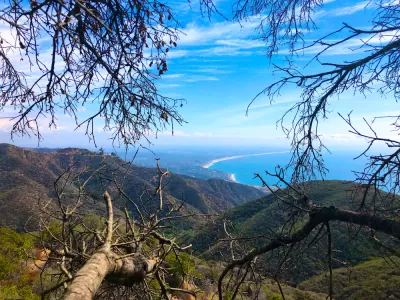The Mountains Recreation and Conservation Authority has acquired the final 150 acres of the 325-acre Triangle Ranch open space in the Santa Monica Mountains.

Triangle Ranch, a 325-acre Santa Monica Mountains property once earmarked for the construction of luxury homes, will now be preserved as permanent open space. The Mountains Recreation and Conservation Authority (MRCA) announced a few days ago that it closed escrow on the property in the central Santa Monica Mountains south of the city of Agoura Hills. The breathtaking landscape, visible to thousands of daily motorists on Kanan Road, has long been identified as a crucial linkage for habitat preservation, watershed protection, and wildlife movement.
This final, Phase 4 acquisition represented an effort of many years and multiple public funding sources and demonstrates the tenacity of the MRCA, the Santa Monica Mountains Conservancy, and area elected officials to preserve the ecologically significant gateway to the Santa Monica Mountains. The MRCA was able to cobble together funds to purchase the property in phases, beginning with the Phase 1 acquisition of 60 acres in 2018. The acquisition of Phases 2 and 3 (40 and 70 acres, respectively,) followed soon after. The purchase of the final 150 acres proved to be the most challenging.
At the request of State Senator Henry Stern and Assemblymember Richard Bloom, Governor Gavin Newsom’s 2021-2022 State Budget set aside $8 million for the Phase 4 acquisition. This contributes to California’s 30 x 30 initiative commitment to combat the global biodiversity and climate crises and conserve at least 30 percent of California’s land and coastal waters by the year 2030.
For more details, please read the source article by John Loesing.
FULL STORY: Agencies complete 325-acre open space acquisition in heart of the Santa Monicas

Study: Maui’s Plan to Convert Vacation Rentals to Long-Term Housing Could Cause Nearly $1 Billion Economic Loss
The plan would reduce visitor accommodation by 25,% resulting in 1,900 jobs lost.

North Texas Transit Leaders Tout Benefits of TOD for Growing Region
At a summit focused on transit-oriented development, policymakers discussed how North Texas’ expanded light rail system can serve as a tool for economic growth.

Why Should We Subsidize Public Transportation?
Many public transit agencies face financial stress due to rising costs, declining fare revenue, and declining subsidies. Transit advocates must provide a strong business case for increasing public transit funding.

How to Make US Trains Faster
Changes to boarding platforms and a switch to electric trains could improve U.S. passenger rail service without the added cost of high-speed rail.

Columbia’s Revitalized ‘Loop’ Is a Hub for Local Entrepreneurs
A focus on small businesses is helping a commercial corridor in Columbia, Missouri thrive.

Invasive Insect Threatens Minnesota’s Ash Forests
The Emerald Ash Borer is a rapidly spreading invasive pest threatening Minnesota’s ash trees, and homeowners are encouraged to plant diverse replacement species, avoid moving ash firewood, and monitor for signs of infestation.
Urban Design for Planners 1: Software Tools
This six-course series explores essential urban design concepts using open source software and equips planners with the tools they need to participate fully in the urban design process.
Planning for Universal Design
Learn the tools for implementing Universal Design in planning regulations.
City of Santa Clarita
Ascent Environmental
Institute for Housing and Urban Development Studies (IHS)
City of Grandview
Harvard GSD Executive Education
Toledo-Lucas County Plan Commissions
Salt Lake City
NYU Wagner Graduate School of Public Service





























